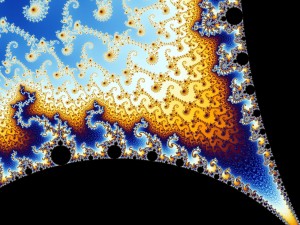“Crowd Actions, (Reverse) Design and Complexity”
Green College, UBC Tuesday, November 3, 2015 at 5 pm.
Paired with Ivan Beschastnikh, “What’s under the hood? Recovering specifications of software systems,” whose presentation follows mine.
Some prefer to view crowds as complex adaptive systems, in which case one might “reverse engineer” crowd actions to analyze the articulations and flux that changed too quickly to be captured in real time. There is a goodly amount of tension between theory and practice, though, neatly presented via another complex adaptive system: modernist narrative fiction. This presentation compares conventional analytical approaches to two famous crowd actions, the Irish Easter Rising (1916) and the London Battle at Cable Street (1936), to roughly contemporaneous fictional representations of crowd movements and collective mental states.

Image: Created by Wolfgang Beyer with the program Ultra Fractal 3; accessed from Wikimedia Commons 21 August 2015. <https://commons.wikimedia.org/wiki/File:Mandel_zoom_09_satellite_head_and_shoulder.jpg>.
